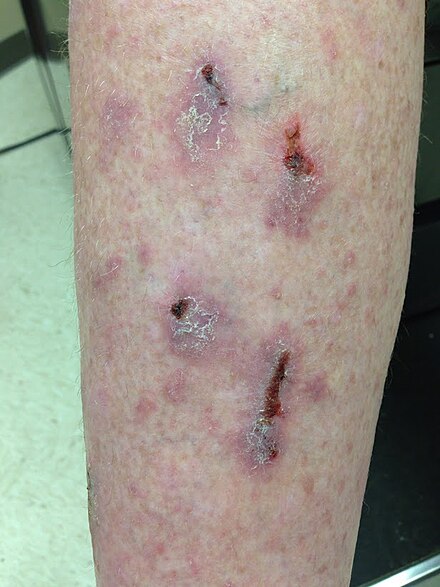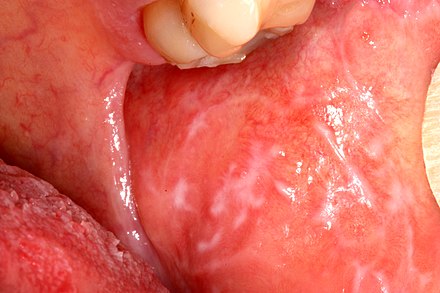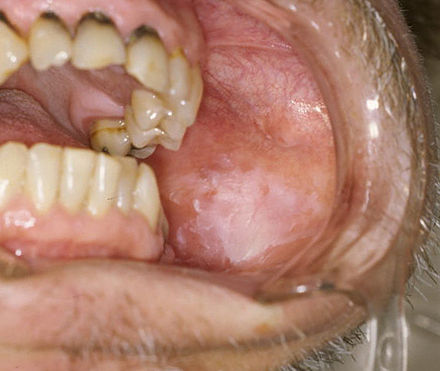Lichen Planus
Lichen planus (LP) is a chronic inflammatory and autoimmune disease affecting the skin, nails, hair, and mucous membranes. It is characterised by polygonal, flat-topped, violaceous papules and plaques with overlying reticulated, fine white scale (Wickham's striae).
LP commonly affects the dorsal hands, flexural wrists, forearms, trunk, anterior lower legs, and oral mucosa. The cause of LP is unknown, but it is believed to result from an autoimmune process with an unidentified trigger. There is no cure, and treatments aim to control symptoms.

Classification
Site
LP can be classified based on the site of involvement: mucosal or cutaneous surfaces. Cutaneous forms affect the skin, scalp, and nails, while mucosal forms involve the lining of the gastrointestinal tract, larynx, genitals, peritoneum, ears, nose, bladder, and conjunctiva of the eyes.
Pattern
LP lesions can occur in various forms including papular, annular, linear, hypertrophic, atrophic, bullous, actinic, ulcerative, pigmented, follicular, and inverse. Each form is characterised by distinct clinical features and distribution.
Signs and Symptoms
Skin
The most common presentation of cutaneous LP is a well-defined area of purple-coloured, itchy, flat-topped papules with interspersed lacy white lines (Wickham's striae). This is described by the "6 Ps": planar (flat-topped), purple, polygonal, pruritic, papules, and plaques. Variants can affect extremities, palms, soles, intertriginous areas, nails, and scalp.


Mucous Membranes
Oral LP is a form of mucosal LP that may occur alone or with other variants. Six clinical forms are recognised: reticular, erosive/ulcerative, papular, plaque-like, atrophic, and bullous. The reticular form is the most common, characterised by lacy white lines (Wickham's striae) and usually asymptomatic. Erosive/ulcerative is the most severe form, presenting with painful ulcers and erosions.

Diagnosis
Skin
Diagnosis of cutaneous LP involves patient history, clinical presentation, and physical examination, including a thorough inspection of the entire cutaneous surface. A skin biopsy may be performed to confirm the diagnosis, with punch biopsy being significant. Direct immunofluorescence can be useful in differentiating from autoimmune vesiculobullous diseases.
Mouth
Diagnosis of oral LP is confirmed through patient history, physical examination, and histologic findings. It is essential to evaluate for medication history, dental restorations, and exposure to possible triggers. Biopsies are useful, especially for erythematous and erosive LP, to confirm the diagnosis and rule out other conditions.
Treatment
There is no cure for LP; treatment aims for symptomatic relief or cosmetic concerns. Topical or systemic corticosteroids are first-line treatments. For cutaneous LP, treatments include retinoids, sulfasalazine, and phototherapy. In oral LP, improving oral hygiene, eliminating precipitating factors, and using topical corticosteroids are initial management steps. Calcineurin inhibitors may be used if corticosteroids are ineffective.
Prognosis
Cutaneous LP lesions typically resolve within six months to a year, but mucosal LP lesions may persist longer and are difficult to treat. Cutaneous LP does not carry a risk of skin cancer, but oral LP, especially the erythematous or erosive forms, may increase the risk of oral squamous cell carcinoma. Regular follow-up is recommended to monitor disease activity and detect early signs of malignancy.
Epidemiology
LP has an estimated prevalence of 0.2% to 5% worldwide, more commonly affecting females and diagnosed between ages 30 and 60. Oral LP is common, with a prevalence of about 1.27-2.0%, occurring more frequently in middle-aged individuals.


History
LP was first described in 1869 by Erasmus Wilson. The characteristic surface markings, or striae, were described by Weyl in 1885 and further explained by Wickham in 1895. The origin of the word comes from the Greek "Leichen" (tree moss) and Latin "planus" (flat and even surface).

Self-assessment MCQs (single best answer)
What is the primary characteristic of Lichen Planus (LP) lesions?
Which of the following is NOT a common site for Lichen Planus involvement?
Which clinical form of oral Lichen Planus is characterised by lacy white lines and is usually asymptomatic?
What is the first-line treatment for cutaneous Lichen Planus?
What is the estimated prevalence range of Lichen Planus worldwide?
Which of the following is a risk associated with oral Lichen Planus, particularly the erythematous or erosive forms?
What historical figure first described Lichen Planus in 1869?
Which of the following is NOT typically involved in the diagnosis of Lichen Planus?
What does the acronym "6 Ps" stand for in the context of Lichen Planus?
What is the primary purpose of treatment for Lichen Planus?
Dentaljuce
Dentaljuce provides Enhanced Continuing Professional Development (CPD) with GDC-approved Certificates for dental professionals worldwide.
Founded in 2009 by the award-winning Masters team from the School of Dentistry at the University of Birmingham, Dentaljuce has established itself as the leading platform for online CPD.
With over 100 high-quality online courses available for a single annual membership fee, Dentaljuce offers comprehensive e-learning designed for busy dental professionals.
The courses cover a complete range of topics, from clinical skills to patient communication, and are suitable for dentists, nurses, hygienists, therapists, students, and practice managers.
Dentaljuce features Dr. Aiden, a dentally trained AI-powered personal tutor available 24/7 to assist with queries and provide guidance through complex topics, enhancing the learning experience.
Check out our range of courses, or sign up now!


